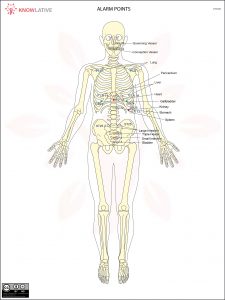A set of 14 special points that give a read-out of stress involved in the 14 acupuncture meridians.
Traditional Chinese Medicine (TCM) describes only 12 Alarm Points (called Anterior Mu Points or Front-Mu) and uses them to assess and balance the energy of the organs (Zang-Fu).They are:
- LU 01 (Central Residence) as the alarm point for LU (Lung Channel – Shou Tai Yin);
- LR 14 (Cycle Gate) as the alarm point for LR (Liver Channel – Zu Jue Yin);
- GB 24 (Sun and Moon) as the alarm point for GB (Gallbladder Meridian – Zu Shao Yang);
- GB 25 (Capital Gate) as the alarm point for KI (Kidney Channel – Zu Shao Yin);
- LR 13 (Completion Gate) as the alarm point for SP (Spleen Channel – Zu Tai Yin);
- ST 25 (Heaven’s Pivot) as the alarm point for LI (Large Intestine Channel – Shou Yang Ming);
- CV 17 (Chest Centre) as the alarm point for PC (Pericardium Channel – Shou Jue Yin);
- CV 14 (Great Gateway) as the alarm point for HT (Heart Channel – Shou Shao Yin);
- CV 12 (Middle Cavity) as the alarm point for ST (Stomach Channel – Zu Yang Ming);
- CV 05 (Stone Gate) as the alarm point for TH (Triple Heater Channel – Shou Shao Yang);
- CV 04 (Gate of the Source) as the alarm point for SI (Small Intestine Channel – Shou Tai Yang);
- CV 03 (Middle Pole) as the alarm point for BL (Bladder Channel – Zu Tai Yang).
In Specialized/Applied Kinesiology we also use:
- GV 26 (Man’s Middle) as the alarm point for GV (Governing Vessel – Du Mai);
- CV 24 (Container of Fluids) as the alarm point for CV (Conception Vessel – Ren Mai).
These extra alarm points are not used in Touch for Health, but are used in many other branches of Kinesiology.
In TCM an alarm point is both diagnostic and therapeutic. The diagnostic aspect is very important in kinesiology. When a Meridian is out of balance, the alarm point is tender and it will respond to a Circuit Localization (CL) or a Therapy Localization/Location (TL).
Depending on how they are used, these points can determine if a meridian has a deficiency of energy or an excess of energy that has ‘blown the circuit’.

